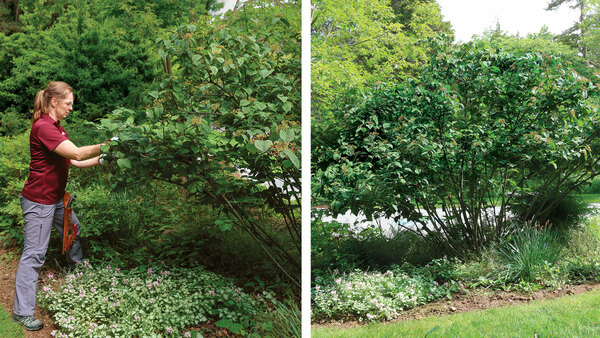Due to their hardiness and many seasons of interest, viburnums are increasingly popular in home landscapes. Executive editor Danielle Sherry shows you how to get your viburnum off to a healthy start with proper planting. You can learn more about different viburnum varieties in this article by Ken Twombly from Fine Gardening #75.
It can be risky for a nursery owner to go out on a limb about naming his favorite plants. But I have absolutely no qualms about saying that viburnums are my pick for the most versatile and gardenworthy genus of shrubs. Besides having attractive foliage and growth habits, the best viburnums also offer lovely—sometimes even fragrant—flowers. Many also boast colorful fruits and stunning fall foliage. In addition, the fruits are appealing to birds and other wildlife. What more could you ask of a shrub?
As a garden designer, whenever I’ve needed a shrub for a problem area—dry, wet, sunny, or shady—a viburnum has always come to the rescue. There are more than 150 species of Viburnum; many are native to North America, growing in USDA Hardiness Zones 2 to 9. My current garden is in Zone 6, Connecticut, but I’ve also grown viburnums in the Zone 2 climate of Vermont. Read more.
Plant a Viburnum: Step by Step
Learn how to plant a viburnum with this step-by-step guide.
1. Dig a hole two to three times wider than the root ball. This will provide lots of room for the roots to expand into.
2. Soak the area with a hose before digging if it’s late in the season. This will make it much easier to dig.
3. Cut away any twine or wire that is securing the burlap to the bottom of the plant.
4. Remove all of the burlap. This will help keep the roots more moisturized.
5. Place your viburnum into the hole. The hole should be deep enough so that the top of the root ball sits at the same level as the surrounding ground. If the plant is placed in a hole that is too deep, it can get diseased easily.
6. Put some soil back into the hole to about halfway and water the shrub. This will help get rid of any air pockets, and it helps to stabilize the shrub overall.
7. Finish backfilling the hole.
8. Build a small ring of soil around the outside edge of the planting hole. It should be high enough to be able to hold 3 to 5 gallons of water when you irrigate.
9. Water inside the soil ring, and allow the water to soak into your newly planted shrub.
10. Remember to consistently water your viburnum about once a week through the rest of the growing season. It is especially important to consistently water your shrub if there is not much rainfall.
Enjoy your viburnum’s beautiful blooms throughout the next seasons!




















Comments
Log in or create an account to post a comment.
Sign up Log in